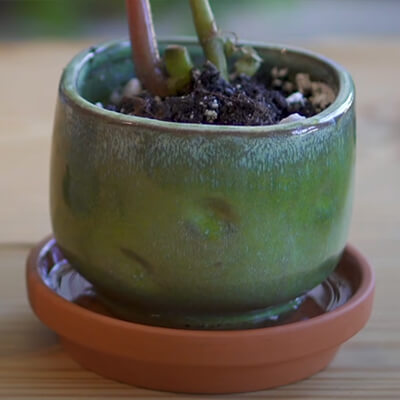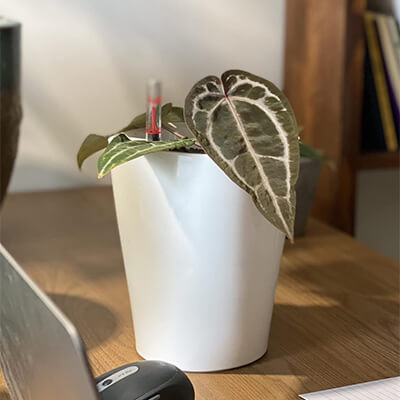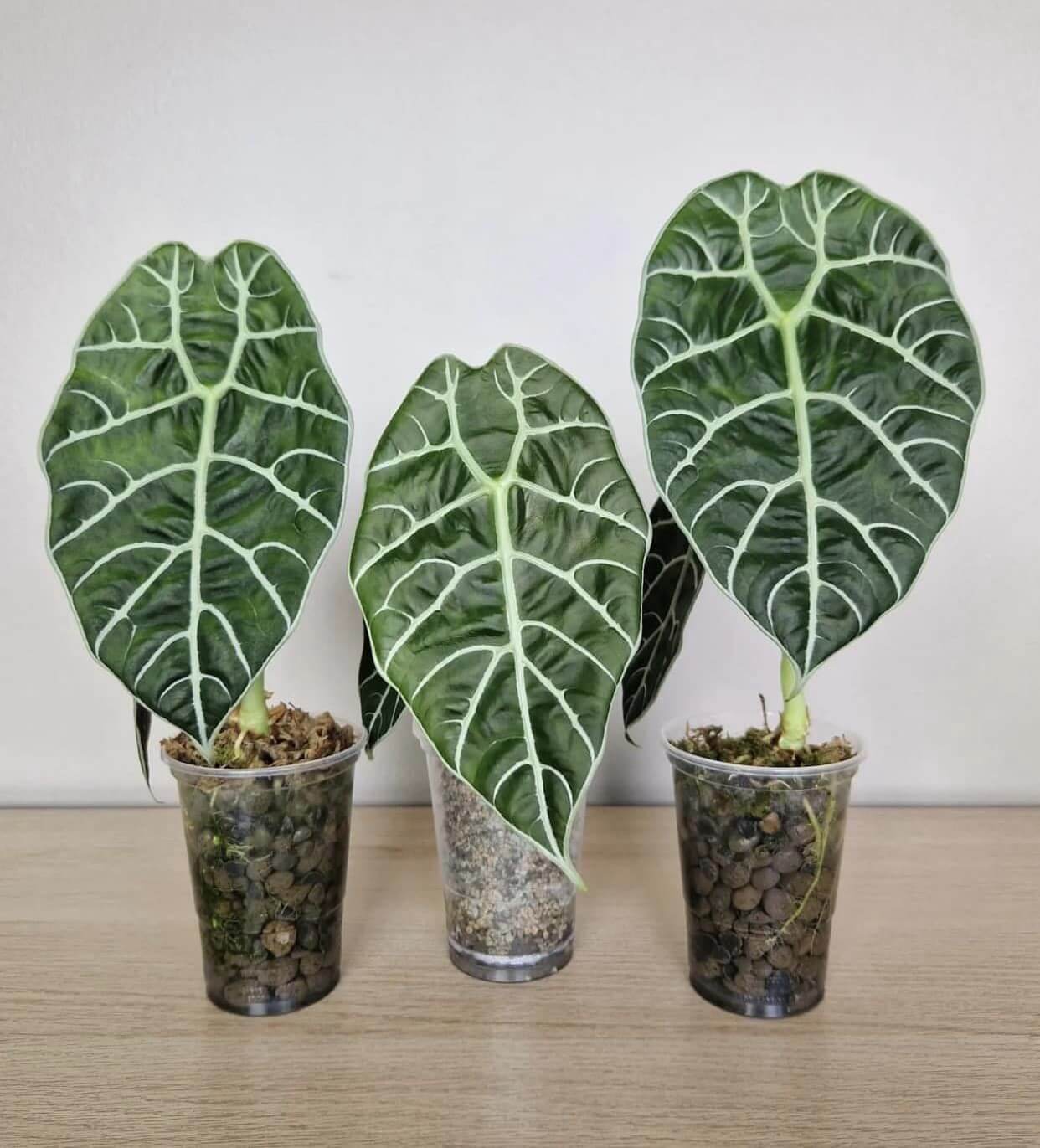Watering houseplants seems like a simple task, yet it’s an art form requiring knowledge and attention.
Each plant species has unique needs, influenced by factors like humidity, light, and the environment of your home. Understanding these nuances ensures your green friends not only survive but thrive.
But what if there was a way to simplify this process, making plant care more worry-free? This is where semi-hydroponics comes in – a revolutionary method that transforms the way we think about plant care.
Summary
TL;DR: Complete Guide to Watering Houseplants
- Kebab Stick Method: A simple trick to check soil moisture using a wooden stick; if soil sticks to it, it’s moist.
- Plant-Specific Tips:
- Alocasia: Weekly watering, avoid waterlogging.
- Philodendron: Water when top soil is dry.
- Monstera: Water when topsoil is 75-80% dry.
- Pothos: Water every 1-2 weeks, depending on soil dryness.
- Ferns: Keep soil moist, water every 2-3 days.
- Hoyas: More water in growing seasons, let soil almost dry out.
- Watering Techniques: Includes top watering, bottom watering, soaking, self-watering systems, misting, and using moisture meters.
- Semi-Hydroponics: An alternative method using an inorganic medium like LECA or Pon for easier care and consistent moisture.
- Understanding each plant’s unique watering needs and the influence of your home environment is crucial for thriving houseplants.

Understanding the Basics of Watering Houseplants
The Variable Needs of Different Species
Watering requirements for houseplants vary widely.
Some plants, like the sensitive African violet, detest having water on their leaves, necessitating unique watering methods such as long-nozzled cans or base watering.
The most common approach involves gently watering over the rim of the pot, filling the space above the compost to the brim.
This technique, while simple, overlooks the fact that each houseplant, and indeed each house, presents a unique set of conditions.
Adapting to Your Home Environment
The key to successful houseplant care lies in adaptation. It’s not as easy as following a once-a-week watering routine.
The environment within your home – the light, the temperature, and the humidity – all play crucial roles in determining the watering needs of your plants.
The quality and temperature of the water used also matter.
Tepid water is generally best, as extreme temperatures can shock the delicate root systems of indoor plants.
Avoiding Common Pitfalls
Overwatering is as harmful as underwatering. A common best practice is to soak the soil thoroughly until water starts to escape through the drainage holes.
This encourages healthy root development. However, it’s crucial not to let the plants sit in water for more than one hour (if you use normal organic soil), as this can lead to root rot – a common plight for many indoor plants.

Watering Trick: The Kebab Stick Method
A simple yet ingenious method using a wooden kebab stick. This makeshift moisture meter offers a practical way to understand the watering needs of your plants, ensuring you give them just the right amount of water.
The Kebab Stick Trick
This method involves sticking a wooden kebab stick into the soil of your plant and observing the soil’s adherence to the stick, which indicates the moisture level. Here’s how it works:
- Insert the Stick: Gently push the kebab stick into the soil.
- Wait a Few Seconds: Let it sit briefly to absorb moisture.
- Observe: Remove the stick and check how much soil sticks to it. The more soil sticking, the wetter your soil is.

General Watering Tips
- Underwatering vs. Overwatering: It’s easier to recover a plant from underwatering than overwatering. When in doubt, lean towards less water.
- Tailor to Your Plant: These guidelines can vary depending on the specific plant within each category. Adjust as needed based on your plant’s response.
When to Water Specific Houseplants
Caring for houseplants involves understanding the unique watering needs of each species. Let’s delve into the specifics for some popular houseplants.
Do note that this is just our general advice. There are a lot of other factors like your environment, humidity, temperature, etc. when it comes to how fast your soil getting dry.
Alocasia
- Watering Schedule: Once weekly when the soil starts to dry out.
- Important Factors: Consider humidity, potting mix, and water quality.
- Soil Condition: Aim to maintain moist soil without waterlogging.
- Best Time to Water: Morning, to allow excess moisture to evaporate.
- Key to Success: Even moisture is essential, but avoid soggy conditions.
Alocasias, with their stunning foliage, require a careful balance in watering. They prefer a weekly schedule when the soil starts to dry out.
But, it’s not just about frequency; factors like humidity, potting mix, and water quality play significant roles. The goal is to maintain moist soil without waterlogging, and morning watering is ideal to allow excess moisture to evaporate during the day.
Remember, Alocasias prefer even moisture but despise soggy conditions.
Philodendron
- Soil Moisture Check: Water when the top few inches of soil are dry.
- Watering Method: Give a generous soak, allowing water to drain.
- Environment: Keep a humid environment similar to their tropical habitat.
Philodendrons thrive when the top few inches of their soil are dry. A simple finger test to gauge soil moisture can guide your watering schedule.
When it’s time to water, provide a generous soak, allowing excess water to drain away. Keeping a humid environment around them, akin to their native tropical habitat, benefits these plants greatly.
Monstera
- Watering Indicator: When the topsoil is about 75 to 80% dry.
- Watering Technique: Thoroughly, ensuring soil is evenly moist.
- Avoiding Root Rot: Do not let the plant sit in water.
- Adjustments: Based on temperature and humidity.
Monsteras, known for their dramatic leaves, require thorough watering until the soil is evenly moist. Make sure the plant doesn’t sit in water to avoid root rot.
Monitoring the soil’s moisture levels is key – water when the topsoil is about 75 to 80% dry.
Adjusting water frequency based on factors like temperature and humidity is essential for their health.
Pothos
- Frequency: Every 1-2 weeks, allowing the top inch of soil to dry out.
- Environmental Influence: Adjust frequency based on pot size, humidity, and light levels.
- Moisture Check: Always test soil moisture before watering.
Pothos plants are relatively easy to care for but still need attention with watering. The general guideline is to water every 1-2 weeks, allowing the top inch of soil to dry out between watering.
Environmental factors like pot size, humidity, and light levels will dictate the exact frequency. Always check the soil moisture before watering to prevent both over and under-watering.
Ferns
- Water Type: Use distilled water at room temperature or slightly warm.
- Soil Moisture: Keep soil moist but not waterlogged.
- Additional Care: Gentle spray on leaves if they look dry.
- Watering Frequency: Every 2 to 3 days during the growing season.
Ferns love moisture and require distilled water at room temperature or slightly warm. The soil should be kept moist but not waterlogged to prevent root rot. If the leaves look dry, a gentle spray of water can be beneficial.
Regular watering every 2 to 3 days during the growing season, especially for varieties like the Boston Fern, keeps them in optimal condition.
Hoyas
- Seasonal Needs: More water during spring and summer.
- Average Frequency: Every 2 weeks, with misting every few days.
- Soil Dryness: Water after the top layer of soil has dried out.
- Watering Method: Pour water over the soil or use a watering can.
Hoyas need more water during their growth and blooming seasons in spring and summer. On average, watering every 2 weeks and misting every few days is adequate. It’s important to allow the top layer of soil to dry out before watering again.
Choosing a suitable method, like pouring water over the soil or using a watering can, is crucial for their well-being.
Techniques for Watering Houseplants
There are several other effective ways to water your houseplants, each with its own benefits. Understanding these methods can help you cater to the specific needs of each plant in your collection.

Top Watering
- Method: Pour water directly onto the top of the soil using a watering can until you see water coming out of the drainage holes for a few seconds.
- Benefits: Helps to evenly moisten the soil and is ideal for most houseplants.
- Considerations: Be careful to avoid overwatering and ensure your pot has good drainage.

Bottom Watering
- Method: Place the plant in a tray of water for 20-30 minutes, allowing the soil to absorb moisture from the bottom up.
- Benefits: Encourages roots to grow downwards and is great for preventing overwatering.
- Best For: Plants that are susceptible to fungal infections from top watering, like African Violets.
Soaking
- Method: Submerge the entire pot in water until the soil is thoroughly saturated.
- Benefits: Ensures deep water penetration, ideal for plants that have become excessively dry.
- Tips: Allow excess water to drain completely before returning the plant to its usual spot.

Self-Watering Systems
- Method: Use a self-watering pot or a DIY setup with wicks that draw water into the soil from a reservoir.
- Benefits: Consistent moisture level, less frequent watering needed.
- Great For: Semi-hydroponic medium such as LECA, Pon, Pumice, etc.
Misting
- Method: Spray the leaves with water, particularly for tropical plants that thrive in humid conditions.
- Benefits: Increases humidity around the plant, beneficial for leaf hydration.
- Note: Misting is more about providing humidity than watering the soil.
Transitioning to Semi-Hydroponics for Easier Plant Care
Transitioning to semi-hydroponics can revolutionize your approach to houseplant care, especially if you find traditional watering methods challenging or time-consuming.
Detailed article: Successful Semi-Hydro Transition Tips
What is Semi-Hydroponics?
Semi-hydroponics, or hydroculture, is a soilless method of growing plants using an inorganic medium such as LECA (Lightweight Expanded Clay Aggregate) or clay pellets. This medium is porous and highly absorbent, offering a robust and lightweight alternative to traditional potting soil. The beauty of this method lies in its simplicity and efficiency in plant care.
Read more: What is semi-hydroponic?
The Benefits of Semi-Hydroponics
- Less Frequent Watering: One of the most significant advantages is the reduced need for frequent watering. The medium used in semi-hydroponics efficiently wicks moisture and nutrients to the plant roots as needed, maintaining a consistent moisture level.
- Sustainability: This method is often more sustainable than regular potting soil, as the inorganic medium can be reused and doesn’t degrade over time.
- Pest Reduction: The absence of organic matter in the growing medium means there’s a lower chance of pest infestations such as spider mites, a common issue in traditional soil-based planting.
- Preventing Root Rot: Over or underwatering can lead to root rot in traditional planting. Semi-hydroponics, with its consistent moisture level, can significantly reduce this risk.
- Improved Aeration: The soilless medium provides better aeration, promoting healthy root growth and overall plant health.

Making the Switch
Transitioning to semi-hydroponics involves understanding the wet/dry cycle and the differences between soil roots and water roots. When switching, it’s crucial to monitor your plants closely to ensure they adapt well to the new environment.
This method can be especially beneficial for those who tend to over or underwater their plants, offering a more forgiving and user-friendly approach to plant care.
Read more: How to transfer plants from Soil to LECA
Ongoing Watering Care for Semi-Hydroponics
While semi-hydroponics simplifies the watering process, ongoing care is crucial to ensure your plants remain healthy and continue to grow robustly. Here are key practices to follow:
Regular Monitoring of Water Levels
One of the primary responsibilities in semi-hydroponic systems is monitoring the water level in the reservoir. This is essential because the water level dictates how much moisture is available to the plant roots.
- Check Regularly: Depending on the plant type and environmental conditions, the frequency of checks can vary. Generally, a weekly check is a good starting point.
- Maintaining Optimal Levels: Ensure the water level doesn’t drop too low, which could stress the plants. Conversely, too high a level can lead to issues like root rot.
Periodic Flushing of the System
Flushing the system periodically is crucial in semi-hydroponics. Over time, minerals and salts can build up in the water and the growing medium, potentially harming the plants.
- Flushing Process: Every few weeks, drain the existing water from the system and replace it with fresh water. This process washes away accumulated salts and minerals, refreshing the root environment.
- Nutrient Replenishment: If you’re using a nutrient solution, flushing is also a good time to replenish or adjust the nutrient levels according to the plant’s growth stage and health.
Observing Plant Health
Regularly observing your plants can provide insights into their well-being and any adjustments needed in their care routine.
- Look for Signs: Yellowing leaves, stunted growth, or droopy foliage can indicate issues with water or nutrient levels.
- Adjust Accordingly: Based on your observations, you may need to tweak the water level, nutrient concentration, or even the light exposure.
Environmental Considerations
The health of semi-hydroponic plants is also influenced by their surrounding environment.
- Light and Temperature: Ensure your plants are receiving the appropriate amount and intensity of light. Also, maintain a stable temperature suitable for each plant species.
- Humidity Levels: Some plants thrive in higher humidity. Consider using a humidifier or placing water trays near the plants to increase ambient humidity.
Conclusion
Watering houseplants is more than just a routine task; it’s an art that requires understanding, attention, and adaptation to each plant’s unique needs. Whether you’re using the kebab stick method to check soil moisture, opting for traditional watering techniques like top or bottom watering, or exploring the innovative world of semi-hydroponics, the key lies in responding to the specific needs of your plants.
Each species, from the dramatic Monstera to the lush Fern, has its own preferences when it comes to moisture, light, and overall care. The environment of your home, including factors like humidity and light, plays a crucial role in determining how and when to water your plants. This guide has provided you with various methods and tips, ensuring that your green friends not only survive but thrive in their indoor environment.
As you delve into the world of plant care, remember that it’s a journey of learning and discovery. Each plant can teach you something new about the delicate balance of watering, the importance of the right environment, and the joy of seeing your plants flourish. Whether you’re a seasoned plant parent or a beginner, embrace the process, experiment with different methods, and enjoy the rewarding experience of nurturing your houseplants.
Happy planting, and may your green companions bring you as much joy as you bring to them!

